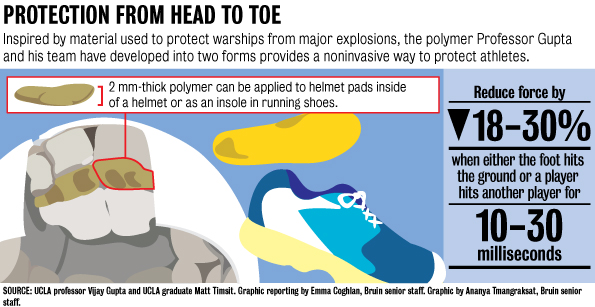Professor Vijay Gupta keeps a large, square piece of plastic-like, yellow-tinged material on the shelf of his office.
And while it may not look like anything special, this polymer could make a world of difference in an arena miles away from Engineering IV– namely, the football field.
Gupta and his team have further developed a polymer that was initially meant for warships to use inside football helmets and running shoes.
Gupta and his assistants have found that the 2 millimeter-thick polymer can be used on the pads of football helmets to reduce the chance of concussions and as an insole to protect runners’ knees.
While their laboratory tests have been successful, they now have to begin functional tests on human beings.
“I can show them the impact data, but people are only really going to believe it when they can feel it themselves. You can never (imitate) exactly the running by impact tests that we do in our labs … The real test is how the runner feels,” Gupta said.
From the battlefield to the football field
Usually, materials that absorb microsecond-long shockwaves– such as the waves from explosions – cannot do so for longer shockwaves that are long – like the ones that occur when a heel hits the ground or helmet impacts helmet. However, Gupta began doing tests and realized that the material he had developed to protect warships could make that transition.
In either form – the insole or helmet liner – the polymer serve as noninvasive protection. It would simply be layered on top of pre-existing helmet pads, making a small difference in the way it feels on an athlete’s head. But that small difference could have a major effect.
Not only does the polymer itself make a big difference, Gupta said, but the combination of it with foam helmet pads makes an even safer helmet.
Matt Timsit, who graduated from UCLA in the spring with a degree in engineering, said that the tests were done with a machine that brought an anvil down from 1-3 feet onto an object. The machine could then register how much force it absorbed.
According to Timsit, these tests indicated an 18-30 percent reduction in force.
“It reduces the probability of concussions significantly,” Timsit said. “We’re excited about it, and we’ve seen consistent results.”
A love for sports
Gupta was born and raised in India – not a country known for American football. But he grew up a sports fan, playing badminton at a high level. And in 1985, the year he started school at the Massachusetts Institute of Technology, he went through a crash course in popular sports of the United States. As most of the major New England teams – the Celtics, Patriots and Red Sox – made it far in the playoffs, Gupta had talented local teams to follow.
Gupta’s roommates were big sports fans and he followed suit, and still follows these sports to this day. The project was a chance for him to combine two of his passions.
Timsit also said his love of sports inspired him to get involved with the project, especially one that concerned such a hot topic in the realm of athletics.
“I thought it would be a great project to get involved in, it’s such a pressing issue and I was excited about the opportunity to advance research and do something that could hopefully make a big impact,” Timsit said.
Engineering at its heart
Dr. George Youssef, now an engineering professor at California State University, Northridge, worked as a graduate assistant on the project during his time at UCLA. While he is a self-proclaimed “nerd” who does not watch sports, he said that he found it interesting to look into the problem and find a solution, because that is at the heart of what he does.
“I think that’s the essence of engineering, it’s finding solutions that enhance the quality of our lives, whether it’s building an airplane or making this polymer for reducing concussions,” Youssef said. “That’s the most rewarding thing – every solution can enhance our lives.”
And an important part of that enhancement is minimizing how big of a change it is. While there are many fancy ways one could design a helmet, Gupta said, helmet companies are not going to really look into an option unless it is practical. This solution – adding 2 millimeters of polymer to helmet pads – makes a dramatic difference without a dramatic change.
College football has been a centerpiece of the concussion debate, and UCLA has seen more and more players diagnosed with head injuries as each season comes. On the medical side, studies have started at UCLA on the long-term impact of concussions.
Dr. Christopher Giza, a professor of pediatric neurology and neurosurgery at UCLA, has been working on a long-term study of sports-related concussions. He is not specifically familiar with Gupta’s polymer, but said it could be a part of a solution.
“There’s no magic bullet that’s going to prevent concussions, there’s many factors that go into why they happen. It certainly doesn’t hurt to have materials that can dampen the forces on an athlete’s head, but these would have to be used in conjunction with other factors,” Giza said.
Giza made it clear that a concussion is not only caused by force but by brain movement, so that even a rapid head jerk with little force could cause a concussion. Gupta also acknowledged this fact, and noted the importance of helmet stability in helping resolve it.
“You have to be cognizant of the problem and what you can do to be a part of the solution,” Gupta said.
Gupta and his colleagues are in the process of beginning functional tests, which they will start out on runners, and have sent the polymer to companies to examine.
If future tests are successful, it could mean a change on the field that doesn’t necessitate rule changes or a mentality shift – rather, just 2 millimeters.

